The medical EMR input device market is valued at USD 5,030.3 million in 2025 and is projected to reach USD 7,887.0 million by 2035, with a CAGR of 4.6%. Between 2021 and 2025, the market grows steadily from USD 4,017.3 million to USD 5,030.3 million, passing through values of USD 4,202.1 million, USD 4,395.4 million, USD 4,597.6 million, and USD 4,809.1 million. This early growth is primarily driven by the increasing adoption of electronic medical records (EMRs) in healthcare institutions, which boosts demand for input devices such as touchscreens, keyboards, and voice recognition systems. The rise in digital health technologies, along with healthcare automation, contributes to this steady upward trend.
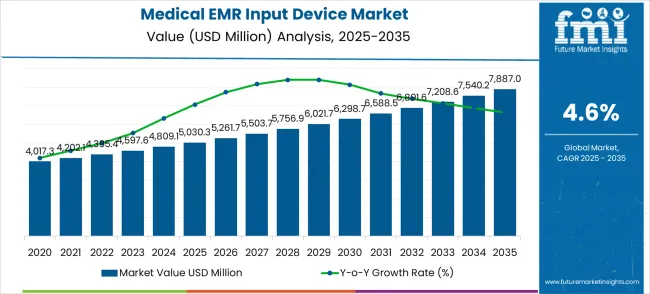
Between 2026 and 2030, the market advances from USD 5,030.3 million to USD 6,298.7 million, moving through intermediate values of USD 5,261.7 million, 5,503.7 million, 5,756.9 million, and 6,021.7 million. This period witnesses a more pronounced rise, influenced by the expansion of telemedicine and remote healthcare services, further driving demand for EMR input devices. Innovations in user-friendly and voice-activated technologies, along with a greater emphasis on patient data security and compliance with healthcare regulations, also fuel the growth in this phase.
From 2031 to 2035, the market grows from USD 6,298.7 million to USD 7,887.0 million, with intermediate values of USD 6,588.5 million, USD 6,891.6 million, USD 7,208.6 million, and USD 7,540.2 million. This acceleration reflects the broader digital transformation in healthcare and the continuous improvement of EMR input device functionality.
| Metric | Value |
|---|---|
| Estimated Value in (2025E) | USD 5,030.3 million |
| Forecast Value in (2035F) | USD 7,887.0 million |
| Forecast CAGR (2025 to 2035) | 4.6% |
The healthcare IT market contributes about 30-35%, as the growing adoption of electronic medical records (EMR) systems across hospitals, clinics, and healthcare facilities drives the need for efficient and reliable input devices. The medical devices market adds roughly 20-25%, with input devices such as keyboards, touchscreens, and voice recognition systems being integrated into medical equipment for enhanced data entry and patient record management. The software and application market accounts for approximately 15-18%, as the increasing use of specialized EMR software and mobile applications requires compatible input devices for seamless interaction. The healthcare infrastructure market contributes about 10-12%, as healthcare facilities upgrade their IT systems and equipment to support EMR systems, boosting demand for input devices. The telecom and communication market provides about 8-10%, driven by the growth of telemedicine and remote patient monitoring services, which rely on EMR input devices for accurate data capture and communication between healthcare providers.
Market expansion is being supported by the increasing demand for healthcare digitization solutions and the corresponding need for high-efficiency input systems in medical documentation applications across global hospital and clinical healthcare operations. Modern healthcare providers are increasingly focused on specialized input technologies that can improve clinical workflow efficiency, reduce documentation errors, and enhance patient care delivery while meeting stringent healthcare requirements. The proven efficacy of medical EMR input devices in various healthcare applications makes them an essential component of comprehensive healthcare digitization strategies and medical documentation production.
The growing emphasis on digital healthcare transformation and advanced clinical workflow optimization is driving demand for ultra-efficient medical EMR input devices that meet stringent performance specifications and regulatory requirements for healthcare applications. Medical technology manufacturers' preference for reliable, high-performance input systems that can ensure consistent documentation outcomes is creating opportunities for innovative input technologies and customized healthcare solutions. The rising influence of healthcare regulations and clinical protocols is also contributing to increased adoption of premium-grade medical EMR input devices across different healthcare applications and medical systems requiring specialized input technology.
The medical EMR input device market represents a specialized growth opportunity, expanding from USD 5,030.3 million in 2025 to USD 7,887.0 million by 2035 at a 4.6% CAGR. As healthcare providers prioritize workflow efficiency, regulatory compliance, and clinical performance in complex healthcare digitization processes, medical EMR input devices have evolved from a niche healthcare technology to an essential component enabling clinical documentation, workflow optimization, and multi-stage healthcare delivery across hospital clinical departments and specialized medical applications.
The convergence of healthcare digitization expansion, increasing electronic health record adoption, specialized clinical organization growth, and medical workflow requirements creates sustained momentum in demand. High-efficiency formulations offering superior input performance, cost-effective touchscreen tablet systems balancing performance with economics, and specialized handheld variants for critical applications will capture market premiums, while geographic expansion into high-growth Asian healthcare markets and emerging market penetration will drive volume leadership. Regulatory emphasis on healthcare data accuracy and clinical workflow reliability provides structural support.
The market is segmented by device type, application, and region. By device type, the market is divided into Touchscreen Tablets, Handheld Terminals, Voice Input Devices, All-in-One Workstations, and Others. Based on application, the market is categorized into Hospital Clinical Departments, Outpatient Clinics, Nursing Facilities, Telemedicine Centers, and Others. Regionally, the market is divided into Asia Pacific, North America, Europe, Latin America, and the Middle East & Africa.
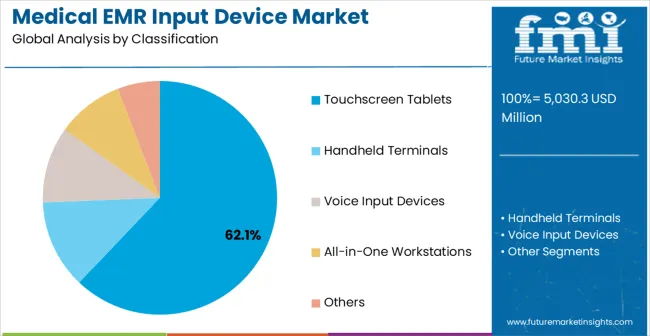
The Touchscreen Tablets segment is projected to account for 62.1% of the medical EMR input device market in 2025, reaffirming its position as the category's dominant device type. Medical technology manufacturers increasingly recognize the optimal balance of performance and cost-effectiveness offered by touchscreen tablets for most healthcare applications, particularly in hospital clinical departments and medical documentation processes. This device type addresses both performance requirements and economic considerations while providing reliable data entry across diverse healthcare applications.
This device type forms the foundation of most healthcare protocols for clinical documentation applications, as it represents the most widely accepted and commercially viable level of input technology in the industry. Performance control standards and extensive clinical testing continue to strengthen confidence in touchscreen tablet formulations among medical technology and healthcare providers. With increasing recognition of the cost-performance optimization requirements in healthcare digitization, Touchscreen Tablets align with both operational efficiency and clinical workflow goals, making them the central growth driver of comprehensive healthcare digitization strategies.
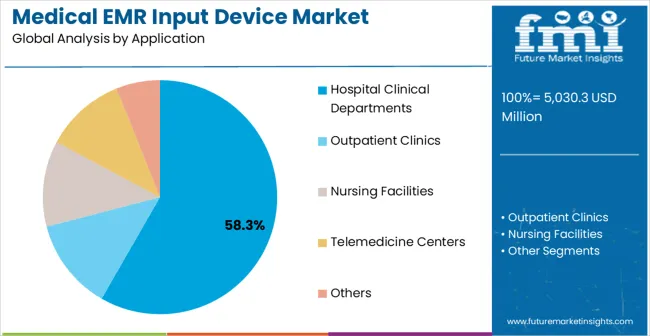
Hospital Clinical Departments are projected to represent 58.3% of medical EMR input device demand in 2025, underscoring their role as the primary application driving market adoption and growth. Medical technology manufacturers recognize that hospital clinical workflow requirements, including complex documentation processes, specialized data entry, and multi-stage clinical systems, often require specialized input devices that standard healthcare technologies cannot adequately provide. Medical EMR input devices offer enhanced workflow efficiency and regulatory compliance in hospital clinical department applications.
The segment is supported by the growing nature of healthcare digitization, requiring sophisticated input systems, and the increasing recognition that specialized input technologies can improve clinical performance and patient care outcomes. The healthcare providers are increasingly adopting evidence-based clinical guidelines that recommend specific input devices for optimal documentation outcomes. As understanding of healthcare workflow complexity advances and regulatory requirements become more stringent, medical EMR input devices will continue to play a crucial role in comprehensive healthcare strategies within the hospital clinical departments market.
The medical EMR input device market is advancing steadily due to increasing recognition of healthcare digitization technologies' importance and growing demand for high-efficiency input systems across the healthcare and clinical workflow sectors. The market faces challenges, including complex integration processes, potential for compatibility variations during implementation and maintenance, and concerns about supply chain consistency for specialized medical equipment. Innovation in input technologies and customized clinical workflow protocols continues to influence product development and market expansion patterns.
The growing adoption of advanced healthcare technology manufacturing facilities is enabling the development of more sophisticated medical EMR input device production and performance control systems that can meet stringent clinical requirements. Specialized manufacturing plants offer comprehensive input services, including advanced touchscreen and voice recognition processes that are particularly important for achieving high-efficiency requirements in healthcare applications. Advanced input channels provide access to premium devices that can optimize clinical workflow performance and reduce documentation errors while maintaining cost-effectiveness for large-scale healthcare operations.
Modern medical technology companies are incorporating digital technologies such as real-time performance monitoring, automated workflow systems, and supply chain integration to enhance medical EMR input device manufacturing and distribution processes. These technologies improve device performance, enable continuous clinical monitoring, and provide better coordination between manufacturers and customers throughout the supply chain. Advanced digital platforms also enable customized performance specifications and early identification of potential device deviations or supply disruptions, supporting reliable healthcare digitization production.
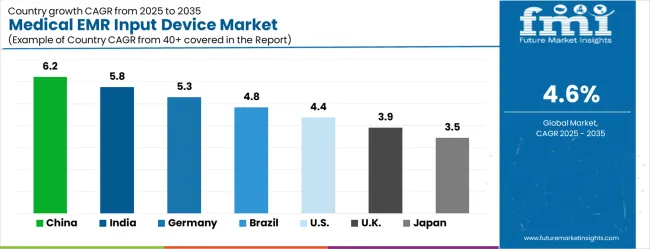
| Country | CAGR (2025-2035) |
|---|---|
| China | 6.2% |
| India | 5.8% |
| Germany | 5.3% |
| Brazil | 4.8% |
| USA | 4.4% |
| UK | 3.9% |
| Japan | 3.5% |
The medical EMR input device market is experiencing varied growth globally, with China leading at a 6.2% CAGR through 2035, driven by the expansion of healthcare infrastructure development, increasing digital healthcare capabilities, and growing domestic demand for high-efficiency input systems. India follows at 5.8%, supported by healthcare digitization expansion, growing recognition of specialized input technology importance, and expanding manufacturing capacity. Germany shows growth at 5.3%, emphasizing advanced healthcare manufacturing technologies and precision clinical workflow applications. Brazil records 4.8% growth, with a focus on developing the healthcare technology and digitization industries. The USA shows 4.4% growth, representing a mature market with established manufacturing patterns and regulatory frameworks. The UK exhibits 3.9% growth, supported by advanced manufacturing frameworks and comprehensive healthcare guidelines. Japan demonstrates 3.5% growth, emphasizing precision healthcare manufacturing infrastructure and systematic clinical workflow approaches.
The report covers an in-depth analysis of 40+ countries with top-performing countries are highlighted below.
Revenue from medical EMR input devices in China is projected to exhibit robust growth with a CAGR of 6.2% through 2035, driven by ongoing healthcare digitization expansion and increasing recognition of high-efficiency input systems as essential healthcare components for complex clinical processes. The country's expanding healthcare technology manufacturing infrastructure and growing availability of specialized input capabilities are creating significant opportunities for medical EMR input device adoption across both domestic and export-oriented healthcare facilities. Major international and domestic medical technology companies are establishing comprehensive production and distribution networks to serve the growing population of healthcare providers and clinical manufacturers requiring high-performance input systems across hospital and clinical applications throughout China's major healthcare development hubs.
The Chinese government's strategic emphasis on healthcare modernization and digital technology advancement is driving substantial investments in specialized input capabilities. This policy support, combined with the country's large domestic healthcare market and expanding clinical digitization requirements, creates a favorable environment for the medical EMR input device market development. Chinese manufacturers are increasingly focusing on high-value healthcare technologies to improve clinical workflow capabilities, with medical EMR input devices representing a key component in this healthcare transformation.
The medical EMR input device market in India is expanding at a CAGR of 5.8%, supported by increasing healthcare digitization accessibility, growing clinical workflow awareness, and developing technology market presence across the country's major healthcare manufacturing clusters. The country's large healthcare sector and increasing recognition of specialized input systems are driving demand for effective high-efficiency input solutions in both hospital clinical and healthcare digitization applications. International medical technology companies and domestic manufacturers are establishing comprehensive distribution channels to serve the growing demand for quality input systems while supporting the country's position as an emerging healthcare technology market.
The healthcare sector continues to benefit from favorable digital health policies, expanding manufacturing capabilities, and cost-competitive healthcare infrastructure development. The country's focus on becoming a global healthcare technology hub is driving investments in specialized input technology and clinical workflow infrastructure. This development is particularly important for medical EMR input device applications, as healthcare providers seek reliable domestic sources for critical input technologies to reduce import dependency and improve supply chain security.
Demand for medical EMR input devices in Germany is projected to grow at a CAGR of 5.3%, supported by well-established healthcare manufacturing systems and precision clinical workflow protocols that emphasize performance, consistency, and regulatory compliance. German medical technology manufacturers consistently utilize high-efficiency input systems for complex healthcare applications and advanced clinical manufacturing, with particular strength in specialty healthcare technologies and high-value clinical systems. The market is characterized by mature manufacturing protocols, comprehensive performance standards, and established relationships between medical technology companies and healthcare providers that support long-term supply agreements and technical collaboration.
Germany's medical technology industry benefits from advanced research and development capabilities, sophisticated manufacturing infrastructure, and strong regulatory frameworks that support high-quality healthcare system production. The country's emphasis on innovation and sustainability is driving the development of more efficient input processes and cleaner production methods for specialized healthcare systems like medical EMR input devices. This focus on technological advancement and environmental responsibility aligns with global trends toward sustainable healthcare technology practices.
The medical EMR input device market in Brazil is anticipated to grow at a CAGR of 4.8% through 2035, driven by healthcare infrastructure development, increasing access to medical technology capabilities, and growing recognition of specialized input systems' importance in complex clinical workflow applications. Brazilian healthcare providers are increasingly adopting high-efficiency input approaches for complex healthcare applications, supported by expanding healthcare market presence and improved technology accessibility across the country's major healthcare regions. The market benefits from Brazil's large domestic healthcare sector and growing participation in regional healthcare technology supply chains.
The healthcare sector is experiencing modernization and expansion, particularly in medical technologies and specialty healthcare systems. The country's strategic location and trade agreements provide access to both domestic and export markets, creating opportunities for medical EMR input device suppliers. Government support for healthcare and medical technology development, combined with increasing private sector investment, is driving infrastructure improvements and capacity expansion in specialized input manufacturing.
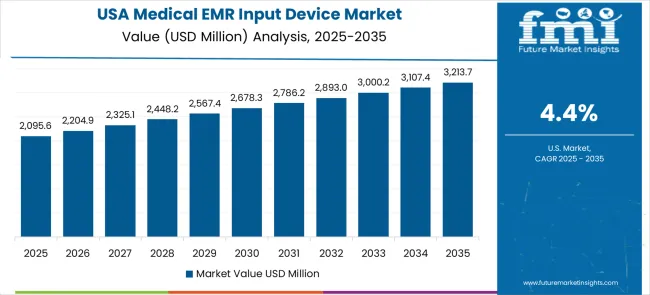
Revenue from medical EMR input devices in the USA is projected to expand at a CAGR of 4.4% through 2035, supported by established medical technology manufacturing systems, evidence-based clinical workflow protocols, and comprehensive healthcare frameworks that emphasize performance, safety, and regulatory compliance. American medical technology manufacturers consistently utilize high-efficiency input systems as part of integrated healthcare approaches, emphasizing clinical outcomes and performance optimization in both hospital clinical and healthcare digitization production. The market benefits from strong research and development capabilities, advanced manufacturing infrastructure, and well-established regulatory frameworks.
The USA healthcare sector's focus on innovation and digital health transformation drives demand for specialized input systems that can support complex clinical workflow processes and meet stringent regulatory requirements. The country's mature market characteristics include established supplier relationships, comprehensive performance standards, and sophisticated logistics networks that support reliable supply chain management for critical healthcare technologies.
The medical EMR input device market in the UK is forecasted to grow at a CAGR of 3.9% through 2035, supported by advanced manufacturing frameworks and comprehensive evidence-based healthcare guidelines that facilitate the appropriate use of high-efficiency input systems for complex healthcare applications. British medical technology manufacturers consistently utilize established protocols for clinical workflow management, emphasizing healthcare outcomes and performance optimization within integrated manufacturing systems that support both domestic healthcare production and export markets. The country benefits from strong research capabilities, established healthcare clusters, and comprehensive regulatory support.
The medical technology and healthcare industries are characterized by high levels of innovation, strong academic-industry collaboration, and emphasis on high-value specialty systems. The country's regulatory environment has created both challenges and opportunities, with increased focus on domestic supply chain development and healthcare security driving investments in specialized input manufacturing capabilities.
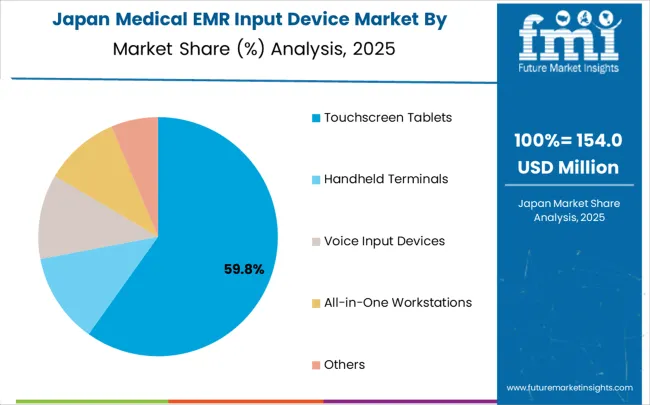
Revenue from medical EMR input devices in Japan is projected to grow at a CAGR of 3.5% through 2035, supported by the country's well-established precision healthcare manufacturing infrastructure, comprehensive performance coverage, and systematic approach to clinical workflow that emphasizes consistency, reliability, and technical excellence. Japanese medical technology manufacturers emphasize evidence-based input system utilization within structured manufacturing frameworks that prioritize clinical workflow effectiveness and system performance in both hospital and specialty healthcare applications. The market is characterized by high technical standards, established performance systems, and long-term supplier relationships.
Japan's medical technology industry benefits from advanced technology, sophisticated performance control systems, and a strong emphasis on continuous improvement. The country's aging population and focus on healthcare efficiency create steady demand for input systems, while the emphasis on high-quality manufacturing supports premium pricing for specialized healthcare systems like medical EMR input devices.
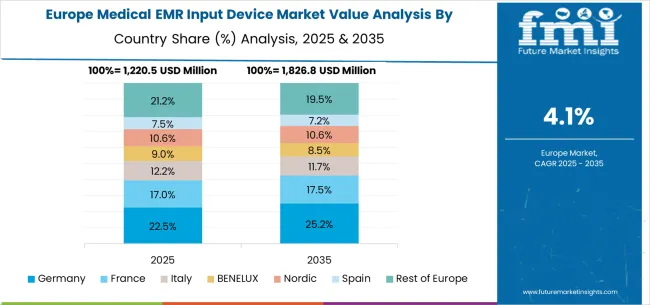
The medical EMR input device market in Europe is projected to grow from USD 1,078.5 million in 2025 to USD 1,691.7 million by 2035, registering a CAGR of 4.6% over the forecast period. Germany is expected to maintain its leadership position with a 28.5% market share in 2025, rising to 29.1% by 2035, supported by its advanced medical technology manufacturing infrastructure, precision clinical workflow capabilities, and strong healthcare presence throughout major healthcare regions.
The United Kingdom follows with a 21.3% share in 2025, projected to reach 21.8% by 2035, driven by advanced manufacturing protocols, medical technology innovation integration, and expanding specialty clinical workflow networks serving both domestic and international markets. France holds an 18.2% share in 2025, expected to increase to 18.6% by 2035, supported by healthcare infrastructure expansion and growing adoption of high-efficiency input systems. Italy commands a 14.1% share in 2025, projected to reach 14.3% by 2035, while Spain accounts for 9.7% in 2025, expected to reach 9.9% by 2035. The BENELUX region is expected to maintain a 4.8% share in 2025, growing to 5.1% by 2035, supported by innovation-friendly regulatory frameworks and strong academic-industry collaboration. The Rest of Europe region, including Nordic countries, Eastern Europe, and smaller Western European markets, is anticipated to hold 3.4% in 2025, declining slightly to 3.2% by 2035, attributed to market consolidation toward larger core markets with established medical technology and healthcare manufacturing capabilities.
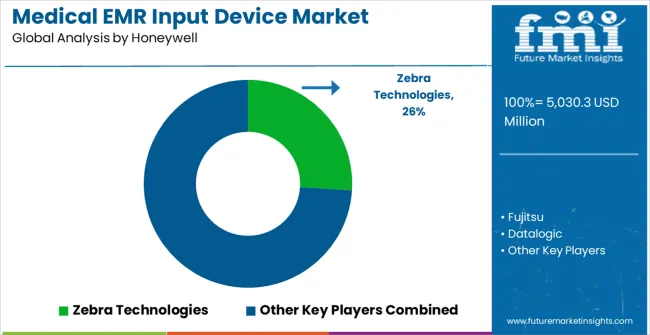
The medical EMR input device market is characterized by competition among established medical technology manufacturers, specialty healthcare equipment companies, and clinical workflow suppliers focused on delivering high-efficiency, consistent, and reliable input systems. Companies are investing in input technology advancement, performance control enhancement, strategic partnerships, and customer technical support to deliver effective, efficient, and reliable medical EMR input solutions that meet stringent healthcare and clinical workflow requirements. Input optimization, performance validation protocols, and supply chain strategies are central to strengthening product portfolios and market presence.
Honeywell leads the market with comprehensive high-efficiency input system offerings with a focus on performance consistency and manufacturing reliability for healthcare applications. Zebra Technologies provides specialized medical EMR input devices with emphasis on clinical workflow applications and comprehensive technical support services. Fujitsu focuses on advanced input technologies and customized healthcare solutions for input systems serving global markets. Datalogic delivers established healthcare systems with strong performance control systems and customer service capabilities.
Advantech operates with a focus on bringing innovative input technologies to specialized healthcare applications and emerging markets. Panasonic provides comprehensive input system portfolios, including medical EMR input devices, across multiple healthcare applications and clinical workflow processes. Barco specializes in customized input solutions and performance management systems for healthcare systems with emphasis on clinical compliance. Elo Touch Solutions provides reliable supply chain solutions and technical expertise to enhance market accessibility and customer access to essential input systems.
| Items | Values |
|---|---|
| Quantitative Units (2025) | USD 5,030.3 million |
| Device Type | Touchscreen Tablets, Handheld Terminals, Voice Input Devices, All-in-One Workstations, Others |
| Application | Hospital Clinical Departments, Outpatient Clinics, Nursing Facilities, Telemedicine Centers, Others |
| Regions Covered | Asia Pacific, North America, Europe, Latin America, Middle East & Africa |
| Countries Covered | China, India, Germany, Brazil, the United States, the United Kingdom, Japan and 40+ countries |
| Key Companies Profiled | Honeywell, Zebra Technologies, Fujitsu, Datalogic, Advantech, Panasonic, Barco, and Elo Touch Solutions |
| Additional Attributes | Dollar sales by device type and application, regional demand trends, competitive landscape, manufacturer preferences for specific input devices, integration with specialty healthcare supply chains, innovations in input technologies, performance monitoring, and clinical workflow optimization |
The global medical EMR input device market is estimated to be valued at USD 5,030.3 million in 2025.
The market size for the medical EMR input device market is projected to reach USD 7,887.0 million by 2035.
The medical EMR input device market is expected to grow at a 4.6% CAGR between 2025 and 2035.
The key product types in medical EMR input device market are touchscreen tablets, handheld terminals, voice input devices, all-in-one workstations and others.
In terms of application, hospital clinical departments segment to command 58.3% share in the medical EMR input device market in 2025.






Our Research Products

The "Full Research Suite" delivers actionable market intel, deep dives on markets or technologies, so clients act faster, cut risk, and unlock growth.

The Leaderboard benchmarks and ranks top vendors, classifying them as Established Leaders, Leading Challengers, or Disruptors & Challengers.

Locates where complements amplify value and substitutes erode it, forecasting net impact by horizon

We deliver granular, decision-grade intel: market sizing, 5-year forecasts, pricing, adoption, usage, revenue, and operational KPIs—plus competitor tracking, regulation, and value chains—across 60 countries broadly.

Spot the shifts before they hit your P&L. We track inflection points, adoption curves, pricing moves, and ecosystem plays to show where demand is heading, why it is changing, and what to do next across high-growth markets and disruptive tech

Real-time reads of user behavior. We track shifting priorities, perceptions of today’s and next-gen services, and provider experience, then pace how fast tech moves from trial to adoption, blending buyer, consumer, and channel inputs with social signals (#WhySwitch, #UX).

Partner with our analyst team to build a custom report designed around your business priorities. From analysing market trends to assessing competitors or crafting bespoke datasets, we tailor insights to your needs.
Supplier Intelligence
Discovery & Profiling
Capacity & Footprint
Performance & Risk
Compliance & Governance
Commercial Readiness
Who Supplies Whom
Scorecards & Shortlists
Playbooks & Docs
Category Intelligence
Definition & Scope
Demand & Use Cases
Cost Drivers
Market Structure
Supply Chain Map
Trade & Policy
Operating Norms
Deliverables
Buyer Intelligence
Account Basics
Spend & Scope
Procurement Model
Vendor Requirements
Terms & Policies
Entry Strategy
Pain Points & Triggers
Outputs
Pricing Analysis
Benchmarks
Trends
Should-Cost
Indexation
Landed Cost
Commercial Terms
Deliverables
Brand Analysis
Positioning & Value Prop
Share & Presence
Customer Evidence
Go-to-Market
Digital & Reputation
Compliance & Trust
KPIs & Gaps
Outputs
Full Research Suite comprises of:
Market outlook & trends analysis
Interviews & case studies
Strategic recommendations
Vendor profiles & capabilities analysis
5-year forecasts
8 regions and 60+ country-level data splits
Market segment data splits
12 months of continuous data updates
DELIVERED AS:
PDF EXCEL ONLINE
Medical Device Tester Market Size and Share Forecast Outlook 2025 to 2035
Medical Device Trays Market Size and Share Forecast Outlook 2025 to 2035
Medical Device Technology Market Size and Share Forecast Outlook 2025 to 2035
Medical Devices Market Size and Share Forecast Outlook 2025 to 2035
Medical Device Packaging Market Size, Share & Forecast 2025 to 2035
Medical Device & Equipment Tags Market Size and Share Forecast Outlook 2025 to 2035
Medical Devices Secondary Packaging Market Analysis by Material and Application Through 2035
Understanding Market Share Trends in Medical Device Packaging
Medical Device Analytical Testing Outsourcing Market Trends – Growth & Forecast 2024-2034
Medical Cleaning Devices Market Overview - Trends & Forecast 2025 to 2035
Cardiac Medical Device Market
Wearable Medical Device Market Size and Share Forecast Outlook 2025 to 2035
Portable Medical Devices Market Analysis - Growth & Forecast 2025 to 2035
Homecare Medical Devices Market Outlook – Industry Growth & Forecast 2025 to 2035
Aesthetic Medical Device Market Analysis - Size, Share, and Forecast Outlook for 2025 to 2035
Medical Far Infrared Therapy Device Market Size and Share Forecast Outlook 2025 to 2035
AI-enabled Medical Devices Market Size and Share Forecast Outlook 2025 to 2035
3D Printed Medical Devices Market is segmented by drug type, treatment and distribution channel from 2025 to 2035
Reprocessed Medical Devices Market Size and Share Forecast Outlook 2025 to 2035
Medical Waste Liquid Collection Device Market Size and Share Forecast Outlook 2025 to 2035

Thank you!
You will receive an email from our Business Development Manager. Please be sure to check your SPAM/JUNK folder too.
Chat With
MaRIA